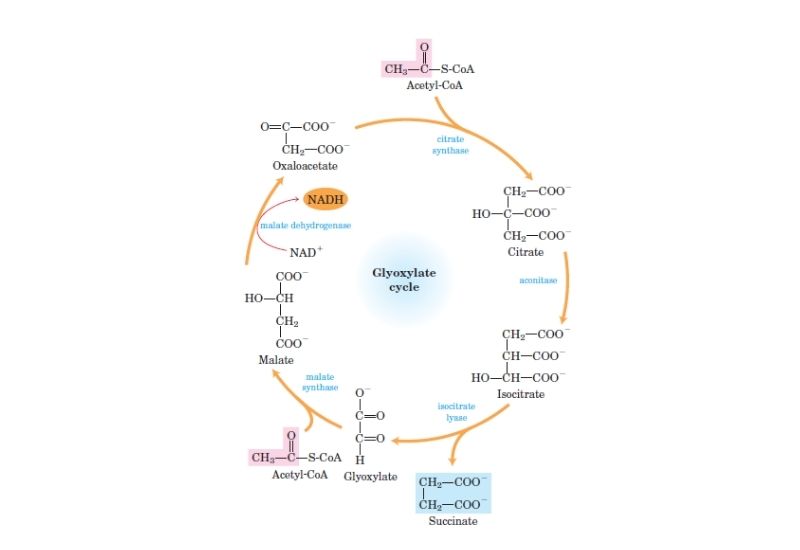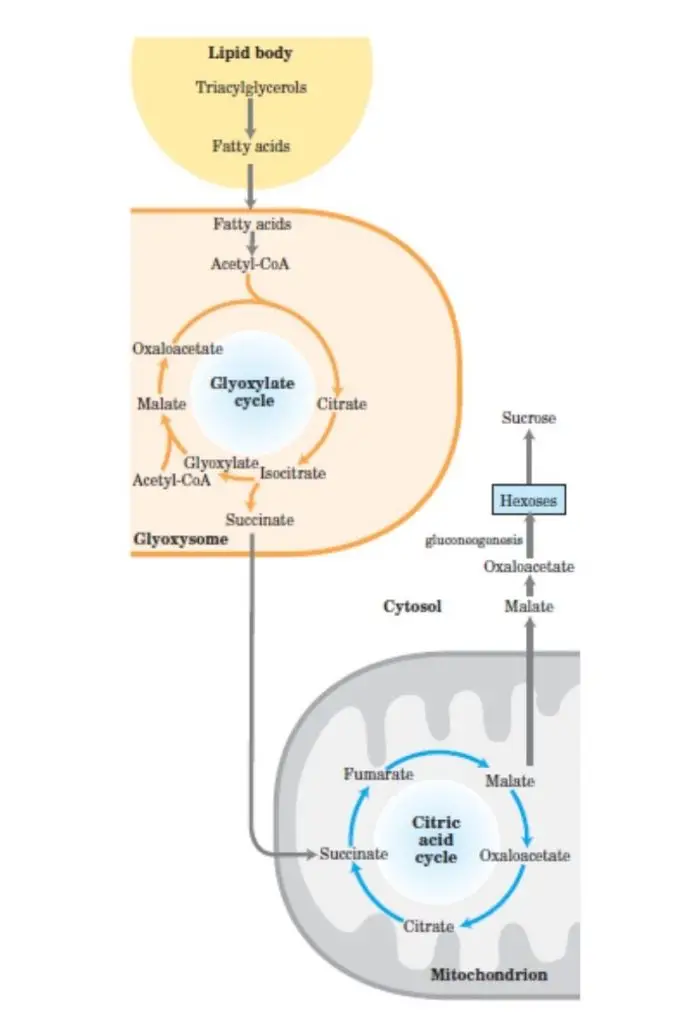Glyoxylate cycle Definition
- Glyoxylate cycle is an anabolic pathway and take place in fungi, bacteria, plants, protist, and nematodes, etc.
- In the Glyoxylate cycle, the acetyl-CoA converted to succinate for the synthesis of carbohydrates.
- There are a total of eight enzymes that are involved in the Glyoxylate cycle and five out of these eight enzymes are associated with the TCA cycle such as citrate synthase, aconitase, succinate dehydrogenase, fumarase, and malate dehydrogenase.
- The Glyoxylate cycle occurs in the glyoxysomes of plant cells, it is a specialized peroxisome.
- It has two additional enzymes called isocitrate lyase and malate synthase.
- This cycle is mainly activated in the germinating seeds of plants and in few microorganisms those use acetate as a sole carbon source.
- Vertebrates can’t synthesize glucose from acetate or fatty acids because they lack the Glyoxylate cycle.
Glyoxylate cycle Steps

- In the first step, Acetyl CoA condenses with the oxaloacetate and forms citrate with the help of the enzyme citrate synthase.
- The citrate is then converted into isocitrate with help of an enzyme called aconitase.
- Isocitrate then cleaved into glyoxylate and succinate with the help of the enzyme isocitrate lyase.
- The glyoxylate condenses with the acetyl CoA and form malate with the help of an enzyme called malate synthase while succinate enters into the TCA cycle within mitochondria and converted into oxaloacetate. This oxaloacetate is converted into phosphoenolpyruvate with the help of an enzyme called phosphoenolpyruvate carboxykinase.
- Now malate converted into Oxaloacetate with the help of enzyme malate dehydrogenase. In this step, NAD is reduced to NADH.
Glyoxylate cycle functions
- During the germination process in plant seeds, the Glyoxylate cycle helps to generate energy from lipids for the formation of shoots.
- It is believed that the Glyoxylate cycle is responsible for the pathogenesis of some pathogenic fungi.
The conversation of dicarboxylic and tricarboxylic acids in germinating seeds occurs in three compartments such as mitochondria, glyoxysomes, and cytosol.
During the conversation, the oxaloacetate from the TCA cycle (mitochondria) enters into the glyoxysomes in the form of aspartate. After that, the aspartate converted into oxaloacetate and enters into the glyoxylate cycle.
The oxaloacetate in the glyoxylate cycle condensed with acetyl CoA and converted into citrate and then citrate to isocitrate. Now isocitrate lysed into Succinate and Glyoxylate. The succinate from here transferred into mitochondria and enters into TCA cycle where it generates malate.
This malate transferred into cytosol and converted into oxaloacetate. This oxaloacetate now enters into the gluconeogenesis pathway and converted into carbohydrates, which are required within a germinating seed to gain energy.

- Text Highlighting: Select any text in the post content to highlight it
- Text Annotation: Select text and add comments with annotations
- Comment Management: Edit or delete your own comments
- Highlight Management: Remove your own highlights
How to use: Simply select any text in the post content above, and you'll see annotation options. Login here or create an account to get started.